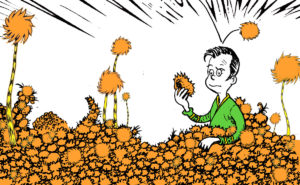 Feel free to read Part 1 and Part 2 if you haven’t already. This time, we’re going to look at is the state of the Dr. Seuss/Star Trek “mash-up” lawsuit as it stands right now.
Feel free to read Part 1 and Part 2 if you haven’t already. This time, we’re going to look at is the state of the Dr. Seuss/Star Trek “mash-up” lawsuit as it stands right now.
Initially , there were three legal complaints filed by the plaintiffs, Dr. Seuss Enterprises:
- Copyright infringement
- Trademark infringement
- Unfair competition
Judge Janis L. Sammartino of the Ninth Circuit Federal Court dismissed the second and third complaints, leaving only the copyright infringement claim as the lawsuit…and that one was “nearly perfectly balanced” based on the “fair use” defense.
But the judge did give the plaintiff a “second chance” to get those two dismissed claims back. She gave them two weeks to file an amended complaint that might change her mind about dismissing trademark infringement and unfair competition.
The plaintiff did, indeed, re-file an Amended Complaint. Not surprisingly, the defendants then filed a new Motion to Dismiss.
The plaintiff wants their two dismissed claims back. The defendant would like to keep those two claims dismissed and, if possible, dismiss the final copyright claim and end the lawsuit completely.
Will either side succeed? Let’s take a closer look…
It’s important to understand why the trademark and unfair competition claims were dropped to begin with. And to understand that, we must first look at the difference between a trademark and a copyright…and also at how fair use applies to both.
The United States Copyright Office says that a copyright protects original works including “literary, dramatic, musical, artistic, and certain other intellectual works.”
The United States Patent and Trademark Office says that a trademark protects “words, names, symbols, sounds or colors that distinguish goods and services from those manufactured or sold by others and to indicate the source of the goods.”
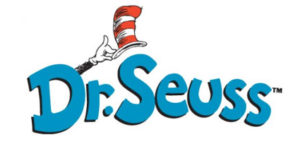 For Dr. Seuss, the stories and illustrations are copyrighted. But the title “Oh, the Places You’ll Go!” is trademarked… along with the name “Dr. Seuss” as part of the logo with the red-and-white striped hat (notice the “TM” in the image to the right).
For Dr. Seuss, the stories and illustrations are copyrighted. But the title “Oh, the Places You’ll Go!” is trademarked… along with the name “Dr. Seuss” as part of the logo with the red-and-white striped hat (notice the “TM” in the image to the right).
Yesterday, we discussed the four factors of fair use for a copyright. With trademarks, the fair use defense has three factors and is called “nominative fair use.” Here are the three factors:
- The product or service cannot be readily identified without using the trademark.
- The user only uses as much of the mark as is necessary for the identification.
- The user does nothing to suggest sponsorship or endorsement by the trademark holder.
Let me provide an example (using Star Trek!) of how nominative fair use would work. Let’s imagine that I’m hosting a small sci-fi convention and I invite Jolene Blalock (the Vulcan T’Pol from Star Trek: Enterprise) as a guest. Since Creation is the only convention company to be licensed by CBS, we’ll assume I’m just one of the many independent cons out there, not licensed by CBS. So I can’t use the words “Star Trek” in my convention program because I don’t have permission, right?
Not exactly…
The law recognizes that sometimes you might have to use a trademark to describe something else that isn’t necessarily that company or service or product. So rather than saying, “Come see our featured guest, Jolene Blalock, who played the alien first officer on that recent incarnation of the long-running sci-fi franchise with a famous starship that had a round saucer section and two cylindrical engines…” they can say, “Come see our featured guest, Jolene Blalock, who played T’Pol on Star Trek: Enterprise.”
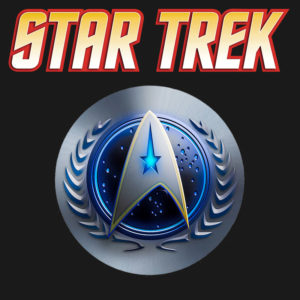 Even though my convention is a for-profit commercial endeavor, I’m allowed to say “Star Trek” just as long as I don’t use the Star Trek logo in its familiar font or show any of the logos from the show. Or if I do use a logo, maybe I alter it a little so it looks similar to but not identical to the trademarked logo. Then, just as long as I don’t imply that my convention is endorsed or sponsored by CBS, it’s okay for me to use the words “Star Trek.” (The question of whether I have to specifically say that my convention is NOT sponsored or endorsed by CBS is taken on a case-by-case basis. But usually, it’s better to err on the side of including the disclaimer…just to be on the safe side.)
Even though my convention is a for-profit commercial endeavor, I’m allowed to say “Star Trek” just as long as I don’t use the Star Trek logo in its familiar font or show any of the logos from the show. Or if I do use a logo, maybe I alter it a little so it looks similar to but not identical to the trademarked logo. Then, just as long as I don’t imply that my convention is endorsed or sponsored by CBS, it’s okay for me to use the words “Star Trek.” (The question of whether I have to specifically say that my convention is NOT sponsored or endorsed by CBS is taken on a case-by-case basis. But usually, it’s better to err on the side of including the disclaimer…just to be on the safe side.)
So back to the Dr. Seuss lawsuit…
The judge determined that the defendants had, in their first motion to dismiss, convincingly argued that all three factors of nominative fair use weighed in their favor. Obviously, in order to be a mash-up of Dr. Seuss and Star Trek, they kinda have to look like a Dr. Seuss book. The key word here being “kinda” because they did change a number of things. Among these are the title (adding “Boldly” is, in fact, a change), and the authors are listed as David Gerrold and Ty Templeton…not Dr. Seuss. That’s a major change. Also, there is a message on the copyright page of the book that states “This is a work of parody, and is not associated with or endorsed by CBS Studios or Dr. Seuss Enterprises, L.P.”
In their response to the first motion to dismiss, the plaintiff didn’t really address the defendants’ arguments. They simply argued that it was too early in the legal process to dismiss a trademark infringement claim at the motion to dismiss pleading stage. However, in previous cases, the Ninth Circuit has done just that.
So, without any real argument against the nominative fair use defense, Judge Sammartino dismissed the trademark infringement claim. She then dismissed the unfair competition claim for essentially the same reason, as unfair competition uses the same arguments as trademark infringement.
Here is a copy of the Judge’s initial order on dismissal , if you’re interested in reading it.
What comes next for the plaintiff?
The plaintiff wants trademark infringement and unfair competition back in the lawsuit. They also want to underscore the financial damages they would incur from the publication of the mash-up.
Here’s the highlights from the amended complaint…
1. It’s not just one trademark, it’s a whole family!
Obviously, the mash-up title adds the word “Boldly” so it’s not an exact copy. But the plaintiffs point out that they didn’t simply trademark “Oh, the Places You’ll Go!” There’s a whole bunch of related marks featuring variations of that title that they own, too.
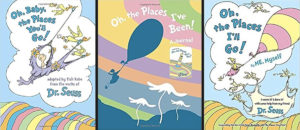 My opinion: The judge already addressed this point in her first ruling and concluded that the plaintiffs have a point that the titles might be confusing or misleading in the marketplace because of their similarity. However, she still dismissed the trademark infringement for a different reason: nominative fair use (which allows for similar or even identical titles).
My opinion: The judge already addressed this point in her first ruling and concluded that the plaintiffs have a point that the titles might be confusing or misleading in the marketplace because of their similarity. However, she still dismissed the trademark infringement for a different reason: nominative fair use (which allows for similar or even identical titles).
2. That’s OUR font, too!
The Dr. Seuss typeface (font) is very distinctive, and consumers can pretty quickly tell if they’re looking at a book written by this beloved author. Although Dr. Seuss Enterprises doesn’t actually own a trademark on their font, it’s so closely identified with their family of products and properties that it pretty much counts as a trademark violation if someone uses it (mostly).
In and of itself, claiming an implied trademark on a font might be a bit of a reach. However, when combined with other aspects of the mash-up closely following the look and feel of the original, it becomes one piece of a much stronger argument. Here’s what the plaintiffs say:
…by willfully misappropriating the stylized font that DSE uses consistently on the front and back covers, spine, and title page of the Dr. Seuss books which consumers recognize as indicative of a Dr. Seuss book, willfully misappropriating the title OH, THE PLACES YOU’LL GO!, and slavishly copying Dr. Seuss’s unique illustration style, Defendants explicitly mislead and confuse consumers as to the Infringing Work’s source and falsely suggest that the Infringing Work is sponsored or endorsed by DSE.
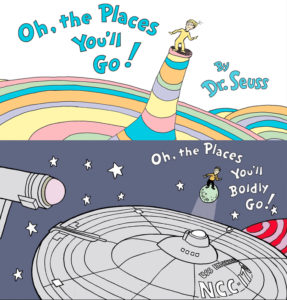 My opinion: While a reasonable argument to make, the judge already ruled that she thought the defendants’ rationale for all the similarities was reasonable. Essentially, if you’re saying “This is a mash-up of Star Trek and Dr. Seuss,” then you’ve got to LOOK like a mash-up of Star Trek and Dr. Seuss…and that means looking like a Dr. Seuss book. Also, the judge recognized that the mash-up was, indeed, transformative enough not to be an exact copy.
My opinion: While a reasonable argument to make, the judge already ruled that she thought the defendants’ rationale for all the similarities was reasonable. Essentially, if you’re saying “This is a mash-up of Star Trek and Dr. Seuss,” then you’ve got to LOOK like a mash-up of Star Trek and Dr. Seuss…and that means looking like a Dr. Seuss book. Also, the judge recognized that the mash-up was, indeed, transformative enough not to be an exact copy.
Of course, the plaintiff has to at least TRY to convince the judge that nominative fair use doesn’t apply. If they say nothing again, the result will be a second dismissal of the trademark and unfair competition complaints.
3. And, hey, they’re implying our endorsement!
As part of their new attempt to argue against nominative fair use, the plaintiff tries very hard to convince the judge that the defendants did NOT do enough to let people know that their mash-up is NOT endorsed by the trademark owners. And that argument looks something like this:
While Defendants included a disclaimer inside the Infringing Work, this disclaimer is ineffective and does not alleviate the potential for consumer confusion. The disclaimer, which is purposely printed in inconspicuously small, fine lettering on the Infringing Work’s third page, states: “This is a work of parody, and is not associated with or endorsed by CBS Studios or Dr. Seuss Enterprises, L.P.” Upon information and belief, consumers are not likely to view a fine-print disclaimer located on the third page of a book prior to purchase. Rather, upon information and belief, consumers look primarily at the front cover, back cover, and spine of a book prior to purchase. Defendants, however, did not include a disclaimer on the Infringing Work’s front cover, back cover, or spine.
Accordingly, the disclaimer is ineffective and does not alleviate the potential for consumer confusion as to Dr. Seuss’s approval, sponsorship, endorsement, or licensing of the Infringing Work. Moreover, the act of blatantly taking intellectual property from two rights holders and calling it a parody or a “mash-up” does not transform infringement into parody or any other form of fair use.
My opinion: They sound really indignant and convincing, but it still might not be enough. The law does NOT say that a defendant must state that they aren’t endorsed…only not to claim that they are endorsed. As the judge herself stated previously, the fact that the cover lists the authors as not being Dr. Seuss is a good sign this isn’t a Dr. Seuss book. And while the message on the copyright page might be “inconspicuously small,” it is still there.
4. We deal with other authors all the time!
A final argument against nominative fair use is the inclusion of a partial list of other authors (not Dr. Seuss himself) who have either written books for or licensed books from the rights holder. In other words, just because the mash-up doesn’t list Dr. Seuss as the author doesn’t mean it’s not going to cause confusion in the marketplace.
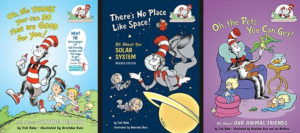 My opinion: Good point, to be honest, and important to include when trying to rebut the nominative fair use defense. But will it be enough? I’m still doubtful.
My opinion: Good point, to be honest, and important to include when trying to rebut the nominative fair use defense. But will it be enough? I’m still doubtful.
5. We license stuff all the time…including to other rights holders!
This point appears intended mainly to buttress their strongest factor on the question of fair use in terms of copyright (not trademark): potential market harm. The defense argues that Dr. Seuss Enterprises is unlikely to ever team up with CBS for a Star Trek mash-up. But there is, apparently, at least some precedent for such things…
 DSE also oversees an extensive licensing and merchandising program that extends the Dr. Seuss Intellectual Property across toys and games, children’s apparel, young adult and adult apparel, puzzles and educational kits, home furnishings, cards and stationery, hats, bags, accessories, party supplies, art, collectibles, classroom materials, and fabrics. Such licensing activities have included collaborations with other rights holders. Examples of such authorized co-branding initiatives include everything from co-branded collegiate bibs to Dr. Seuss Chuck Taylors®
DSE also oversees an extensive licensing and merchandising program that extends the Dr. Seuss Intellectual Property across toys and games, children’s apparel, young adult and adult apparel, puzzles and educational kits, home furnishings, cards and stationery, hats, bags, accessories, party supplies, art, collectibles, classroom materials, and fabrics. Such licensing activities have included collaborations with other rights holders. Examples of such authorized co-branding initiatives include everything from co-branded collegiate bibs to Dr. Seuss Chuck Taylors®
What comes next for the defendants?
There’s a term in American football called the “prevent defense.” Basically, if you have a big enough lead, there’s no need to score lots more points. Just put your efforts into making sure your opponent doesn’t score more points.
ComicMix (the mash-up publisher) isn’t doing this. They’re trying for the knock-out. They want the ENTIRE case dismissed:
DSE still fails to state a claim. The Court may dispose of all claims now, at the pleading stage, because the copyright claim cannot overcome Defendants’ fair use and the remaining claims cannot overcome the nominative fair use defense. Boldly is neither infringing nor unfair and the action should be dismissed.
I won’t go point-by-point through their pleading, but you are welcome to read the hard-hitting arguments here: Motion to Dismiss.
Essentially, they rebut pretty much everything the plaintiff said in its amended complaint, as one would expect. And I suspect the judge will, again, dismiss the trademark and unfair competition claims.
But the one intriguing point they hit is that the copyright infringement claim should now be entirely dismissed, as well, since there is no specific damage claim. Oh sure, there’s hypothetical damages from potential lost revenue or the loss of possible licensing opportunities. But according to the defendants, there is no REAL market harm stated in the amended complain, only potential assumed damages.
The defense tackles those assumed damages with a one-two punch:
1.
Boldly cannot cause any relevant market harm, as DSE does not and cannot plausibly participate in a market for transformative works like Boldly.
In other words, Dr. Seuss Enterprises sells books for children. The mash-up is intended for grown-up Trekkies. Two different markets. And because the judge has already ruled the mash-up as significantly transformative, this argument holds some weight.
2.
DSE alleges that it has licensed “new works based upon, and incorporating” its copyrights and trademarks. But DSE does not, and cannot plausibly, allege that it has licensed or would license any derivative work that creates a hybrid of Dr. Seuss’s books with existing characters and imagery from works from a third party’s entertainment franchise. The first amended complaint does not give rise to a plausible claim that Boldly would cause any harm in any transformative market.
In other words, yeah, they might out license to other authors…but NOT for mash-ups! That’s a whole different animal. So they can’t complain about potential loss of licensing opportunities for mash-ups since they never did one before and likely weren’t going to do one in the future.
My opinion: I think there’s enough in the defense motion to convince the judge to re-dismiss the trademark and unfair competition claims. But I suspect that the judge will let the copyright infringement claim remain in place (allowing the lawsuit to proceed). The plaintiffs stated that they will provide evidence that proves financial harm at a future date in trial. I believe the judge will at least give them that chance.
However, assuming the case does go forward and it’s simply the copyright infringement claim, I think I’d rather be the defendant. Their defense is fair use, and right now, they’re got two of the four factors on their side, one essentially neutral, and only one favoring the plaintiff. And the plaintiffs will have to “put up or shut up” when it comes time to prove actual real damages. And I just don’t think they’ll be able to do that successfully.
So when will we know the judge’s final decision? Not for another couple of months at least. First, the plaintiff gets to respond to the motion to dismiss, and then the defendant replies to that (yeah, just like the Axanar case!).
But I’ll keep you all updated. For some strange reason, I find summarizing and translating the legal filings for my readers to be kinda fun!
